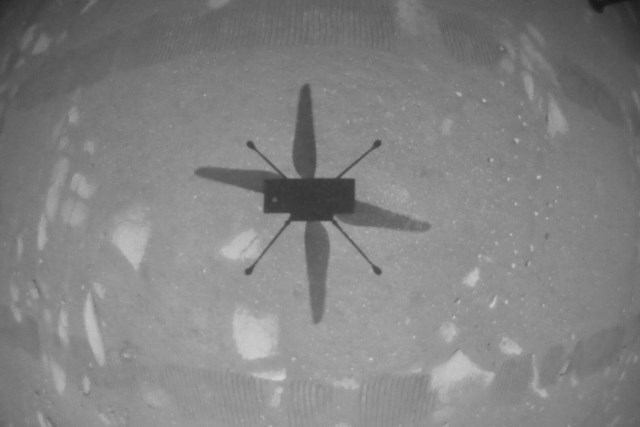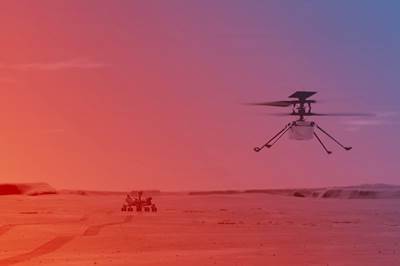NASA Ingenuity helicopter succeeds in historic first flight on Mars
Ingenuity’s two 4-foot-wide carbon fiber and foam core rotor blades successfully interacted with Mars’ gravity and atmosphere, logging a total of 39.1 seconds of flight.

NASA’s Ingenuity Mars Helicopter captured this shot as it hovered over the Martian surface on April 19, 2021, during the first instance of powered, controlled flight on another planet. It used its navigation camera, which autonomously tracks the ground during flight. Photo Credit: NASA/JPL-Caltech
On April 19, NASA’s composites-intensive Ingenuity Mars Helicopter became the first aircraft in history to make a powered, controlled flight on another planet. The Ingenuity team at the agency’s Jet Propulsion Laboratory (JPL, La Cañada Flintridge, Calif., U.S.) confirmed the flight succeeded after receiving data from the helicopter via NASA’s Perseverance Mars rover at 6:46 a.m. EDT (3:46 a.m. PDT).
“Ingenuity is the latest in a long and storied tradition of NASA projects achieving a space exploration goal once thought impossible,” says acting NASA Administrator Steve Jurczyk. “The X-15 was a pathfinder for the space shuttle. Mars’ Pathfinder and its Sojourner rover did the same for three generations of Mars rovers. We don’t know exactly where Ingenuity will lead us, but these results indicate the sky — at least on Mars — may not be the limit.”
The solar-powered helicopter first became airborne at 3:34 a.m. EDT (12:34 a.m. PDT) — 12:33 Local Mean Solar Time (Mars time) — a time the Ingenuity team determined would have optimal energy and flight conditions. Altimeter data indicate Ingenuity climbed to its prescribed maximum altitude of 10 feet (3 meters) and maintained a stable hover for 30 seconds. It then descended, touching back down on the surface of Mars after logging a total of 39.1 seconds of flight. Additional details on the test are expected in upcoming downlinks.
Ingenuity’s initial flight demonstration was autonomous — piloted by onboard guidance, navigation and control systems running algorithms developed by the team at JPL. Because data must be sent to and returned from the red planet over hundreds of millions of miles using orbiting satellites and NASA’s Deep Space Network (DNL), an international array of giant radio antennas that supports interplanetary spacecraft missions, Ingenuity cannot be flown with a joystick, and its flight was not observable from Earth in real time.
NASA Associate Administrator for Science Thomas Zurbuchen has announced the name for the Martian airfield on which the flight took place.
“Now, 117 years after the Wright brothers succeeded in making the first flight on our planet, NASA’s Ingenuity helicopter has succeeded in performing this amazing feat on another world,” Zurbuchen says. “While these two iconic moments in aviation history may be separated by time and 173 million miles of space, they now will forever be linked. As an homage to the two innovative bicycle makers from Dayton, this first of many airfields on other worlds will now be known as Wright Brothers Field, in recognition of the ingenuity and innovation that continue to propel exploration.”
Ingenuity’s chief pilot, Håvard Grip, announced that the International Civil Aviation Organization (ICAO) — the United Nations’ civil aviation agency — presented NASA and the Federal Aviation Administration (FAA) with official ICAO designator IGY, call-sign INGENUITY.
These details will be included officially in the next edition of ICAO’s publication “Designators for Aircraft Operating Agencies, Aeronautical Authorities and Services.” The location of the flight has also been given the ceremonial location designation JZRO for Jezero Crater.
As one of NASA’s technology demonstration projects, the 19.3-inch-tall (49-centimeter-tall) Ingenuity Mars Helicopter contains no science instruments inside its tissue-box-size fuselage. Instead, the 4-pound (1.8-kilogram) composite rotorcraft is intended to demonstrate whether future exploration of the red planet could include an aerial perspective.
This first flight was full of unknowns. NASA reports that Mars has a significantly lower gravity — one-third that of Earth’s — and an extremely thin atmosphere with only 1% the pressure at the surface compared to our planet. This means there are relatively few air molecules with which Ingenuity’s two 4-foot-wide (1.2-meter-wide) carbon fiber and foam core rotor blades can interact to achieve flight. The helicopter contains components, as well as off-the-shelf-commercial parts — many from the smartphone industry — that were tested in deep space for the first time with this mission.
“The Mars Helicopter project has gone from ‘blue sky’ feasibility study to workable engineering concept to achieving the first flight on another world in a little over six years,” says Michael Watkins, director of JPL. “That this project has achieved such a historic first is testimony to the innovation and doggedness of our team here at JPL, as well as at NASA’s Langley and Ames Research Centers, and our industry partners. It’s a shining example of the kind of technology push that thrives at JPL and fits well with NASA’s exploration goals.”
Parked about 211 feet (64.3 meters) away at Van Zyl Overlook (the location where the Perseverance rover observed the Ingenuity Mars Helicopter’s attempt at powered controlled flight), Perseverance not only acted as a communications relay between the helicopter and Earth, but also chronicled the flight operations with its cameras. The pictures from the rover’s Mastcam-Z and Navcam imagers will provide additional data on the helicopter’s flight.
“We have been thinking for so long about having our Wright brothers moment on Mars, and here it is,” says MiMi Aung, project manager of the Ingenuity Mars Helicopter at JPL. “We will take a moment to celebrate our success and then take a cue from Orville and Wilbur regarding what to do next. History shows they got back to work — to learn as much as they could about their new aircraft — and so will we.”
Perseverance touched down with Ingenuity attached to its belly on Feb. 18. Deployed to the surface of Jezero Crater on April 3, Ingenuity is currently on the 16th sol, or Martian day, of its 30-sol (31-Earth day) flight test window. Over the next three sols, the helicopter team will receive and analyze all data and imagery from the test and formulate a plan for the second experimental test flight, scheduled for no earlier than Thursday, April 22. If the helicopter survives the second flight test, the Ingenuity team will consider how best to expand the flight profile.
Related Content
Plant tour: Teijin Carbon America Inc., Greenwood, S.C., U.S.
In 2018, Teijin broke ground on a facility that is reportedly the largest capacity carbon fiber line currently in existence. The line has been fully functional for nearly two years and has plenty of room for expansion.
Read MoreNatural fiber composites: Growing to fit sustainability needs
Led by global and industry-wide sustainability goals, commercial interest in flax and hemp fiber-reinforced composites grows into higher-performance, higher-volume applications.
Read MoreTU Munich develops cuboidal conformable tanks using carbon fiber composites for increased hydrogen storage
Flat tank enabling standard platform for BEV and FCEV uses thermoplastic and thermoset composites, overwrapped skeleton design in pursuit of 25% more H2 storage.
Read MoreCombining multifunctional thermoplastic composites, additive manufacturing for next-gen airframe structures
The DOMMINIO project combines AFP with 3D printed gyroid cores, embedded SHM sensors and smart materials for induction-driven disassembly of parts at end of life.
Read MoreRead Next
NASA Ingenuity Mars helicopter prepares for first flight
The composites-intensive helicopter is to make the first attempt at powered, controlled flight of an aircraft on another planet, with the goal of hovering 3 meters above the Martian surface.
Read More“Structured air” TPS safeguards composite structures
Powered by an 85% air/15% pure polyimide aerogel, Blueshift’s novel material system protects structures during transient thermal events from -200°C to beyond 2400°C for rockets, battery boxes and more.
Read MoreVIDEO: High-volume processing for fiberglass components
Cannon Ergos, a company specializing in high-ton presses and equipment for composites fabrication and plastics processing, displayed automotive and industrial components at CAMX 2024.
Read More


























